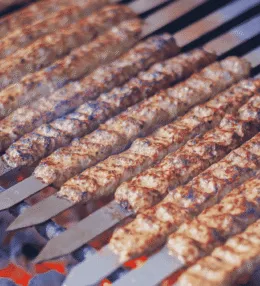
- View
Table of Contents
ToggleGibanica is a beloved Serbian dish that carries both comfort and celebration in its layers. Made with phyllo pastry, cheese, and eggs, it is baked until golden and crisp on the outside while remaining soft and savoury within. It is simple in form yet generous in flavour.
Across Serbia, gibanica appears at family gatherings, religious holidays, and casual everyday meals. Its appeal lies in its versatility. It can be served warm or cold, as a main dish, a side, or even a snack shared among friends.
The pie holds a character that is rustic yet satisfying. Every bite offers a balance of crunchy pastry and creamy filling, creating a dish that feels hearty without being heavy. It is food that invites people to linger at the table.
Want to dive deeper into Serbian Cuisine? Don’t miss our post on 20 Traditional Serbian Foods to Try
What Is Gibanica?
Gibanica is a traditional Serbian cheese pie layered with sheets of phyllo pastry that are soaked or brushed with a mixture of eggs, yoghurt, and cheese. It is assembled in a baking dish and baked until the top turns a rich golden brown.
The pie can be tightly layered or more loosely arranged, depending on regional and family traditions. Some prefer a neat stack of pastry sheets, while others crumple the dough for a rustic texture that makes the filling more prominent.
Often cut into squares or wedges, gibanica is served straight from the tray, making it ideal for sharing. It is a dish that bridges everyday simplicity with the warmth of homemade care.
Ingredients and Taste
The foundation of gibanica is thin phyllo pastry, which creates layers that bake into both crisp and tender textures. The filling is usually made from a combination of white brined cheese, eggs, and yoghurt, whisked together for richness.
Cheese varieties vary depending on what is available. Farmers’ cheese, feta style cheeses, or a mix of the two are common choices, each lending a slightly different saltiness and depth to the filling. Olive oil or butter helps bind the flavours.
When baked, the pie develops a golden crust that contrasts beautifully with the soft, tangy interior. The taste is savoury and creamy, with a gentle sharpness from the cheese and a satisfying crunch from the browned pastry edges.
A Taste of History
Gibanica has deep roots in Serbian rural life, where cheese, eggs, and bread were staples of the household. It grew from the practice of using local dairy and flour to create filling meals that could feed families with modest means.
Over time, the dish became associated with both festive occasions and everyday meals. It was served during religious celebrations such as Christmas and Easter, as well as at weddings and family gatherings, always carrying a sense of togetherness.
Its name is linked to the Serbian verb “gibati”, meaning to fold or sway, which reflects the movement of layering the pastry. This simple action became tied to the rhythm of preparing food that was both practical and celebratory.
Today, gibanica remains a cornerstone of Serbian cuisine. Whether baked in a farmhouse kitchen or a modern city oven, it continues to reflect the country’s agricultural heritage and the value placed on shared meals and simple ingredients.
How to Make Gibanica (Serbian Cheese Pie)
Gibanica is a cherished Serbian pastry that layers crisp phyllo with a rich, savoury cheese and egg filling. Expect a pie that is both rustic and indulgent, with golden edges and a soft, custardy centre. It is perfect for sharing at family gatherings or festive tables. See the recipe card at the bottom for printable directions
Ingredients
For the filling
- 400g feta cheese (or Serbian white brined cheese)
- 200g cottage cheese or ricotta
- 3 large eggs
- 200ml plain yoghurt
- 100ml sunflower oil (or neutral oil)
- 50ml sparkling water (for lightness)
- ½ tsp salt (adjust depending on cheese saltiness)
For the pastry
- 400g phyllo pastry sheets (thin, traditional style)
- 50ml melted butter or sunflower oil (for brushing)
Cooking Instructions
Step 1: Preheat the oven
To begin, preheat your oven to 190°C (375°F). Grease a large baking dish (around 30 x 20 cm) lightly with oil or butter. Move on to preparing the filling.
Step 2: Prepare the cheese mixture
In a large bowl, crumble the feta cheese. Add cottage cheese, yoghurt, eggs, sunflower oil, sparkling water, and salt. Mix until creamy but still slightly textured. Transition to preparing the phyllo.
Step 3: Organise the phyllo pastry
Unroll the phyllo sheets and cover with a damp kitchen towel to prevent drying out. This keeps the pastry pliable while working. Move to layering the base.
Step 4: Layer the base
Place two sheets of phyllo into the greased dish, brushing lightly with melted butter or oil. This forms the crisp foundation. Proceed to the filling.
Step 5: Assemble with filling
Spoon several tablespoons of the cheese mixture onto the phyllo. Tear another sheet into rough pieces, dip into the cheese mixture, and layer loosely across the dish. Continue alternating phyllo and filling until all ingredients are used.
Step 6: Finish with phyllo topping
Top the pie with two intact sheets of phyllo. Brush generously with melted butter or oil to achieve a golden finish. Move to baking.
Step 7: Bake until golden
Bake for 40–45 minutes until the surface is deep golden brown and crisp. If the top browns too quickly, cover loosely with foil. Proceed to cooling.
Step 8: Rest before slicing
Allow the Gibanica to cool for at least 15 minutes before cutting. This helps the filling set while keeping the crust flaky. Transition to serving.
Final Step: Serve warm
Cut into squares or rustic wedges. Serve warm with plain yoghurt or a fresh salad for a complete meal. Presentation tip: Gibanica is traditionally enjoyed straight from the pan at the table, shared among family and friends.
Variations and Substitutions
- Cheese: If Serbian white cheese is unavailable, use Greek feta combined with ricotta or quark for balance.
- Pastry: Substitute filo with puff pastry for a different texture, though filo is traditional.
- Additions: Some versions include spinach or nettle leaves for a greener filling.
- Yoghurt: Kefir can be used for a tangier flavour.
Cooking Tips for Perfect Gibanica
- Use sparkling water in the filling to keep the texture airy and light.
- Always cover phyllo with a damp cloth to prevent cracking.
- Allow the baked pie to rest before cutting to avoid a runny centre.
- For authentic flavour, combine at least two types of cheese.

Gibanica (Serbian cheese pie)
Ingredients
For the filling
- 400 g feta cheese or Serbian white brined cheese
- 200 g cottage cheese or ricotta
- 3 large eggs
- 200 ml plain yoghurt
- 100 ml sunflower oil or neutral oil
- 50 ml sparkling water for lightness
- ½ tsp salt adjust depending on cheese saltiness
For the pastry
- 400 g phyllo pastry sheets thin, traditional style
- 50 ml melted butter or sunflower oil for brushing
Instructions
- To begin, preheat your oven to 190°C (375°F). Grease a large baking dish (around 30 x 20 cm) lightly with oil or butter. Move on to preparing the filling.
- In a large bowl, crumble the feta cheese. Add cottage cheese, yoghurt, eggs, sunflower oil, sparkling water, and salt. Mix until creamy but still slightly textured. Transition to preparing the phyllo.
- Unroll the phyllo sheets and cover with a damp kitchen towel to prevent drying out. This keeps the pastry pliable while working. Move to layering the base.
- Place two sheets of phyllo into the greased dish, brushing lightly with melted butter or oil. This forms the crisp foundation. Proceed to the filling.
- Spoon several tablespoons of the cheese mixture onto the phyllo. Tear another sheet into rough pieces, dip into the cheese mixture, and layer loosely across the dish. Continue alternating phyllo and filling until all ingredients are used.
- Top the pie with two intact sheets of phyllo. Brush generously with melted butter or oil to achieve a golden finish. Move to baking.
- Bake for 40–45 minutes until the surface is deep golden brown and crisp. If the top browns too quickly, cover loosely with foil. Proceed to cooling.
- Allow the Gibanica to cool for at least 15 minutes before cutting. This helps the filling set while keeping the crust flaky. Transition to serving.
- Cut into squares or rustic wedges. Serve warm with plain yoghurt or a fresh salad for a complete meal. Presentation tip: Gibanica is traditionally enjoyed straight from the pan at the table, shared among family and friends.
Nutrition
You May Also Like







Leave a Review